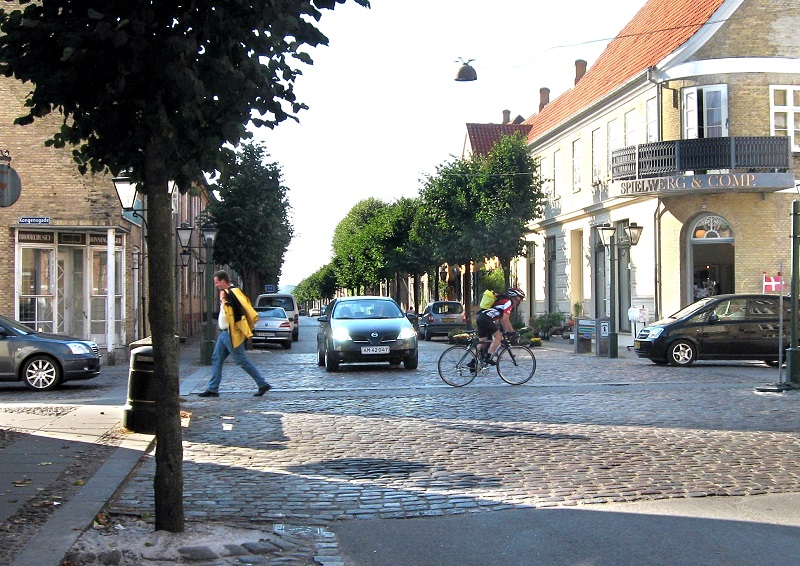How to make roads safer: the debate continues

|
| Above: This crossroads in Christiansfield, Denmark, was an early pioneer of signal-free junctions: the annual accident rate dropped from three to zero after removing traffic signals. |
Contents |
[edit] Introduction
According to the World Health Organization (WHO), the number of annual road traffic deaths on the world's roads reached 1.35 million in 2018. Road traffic injuries are considered to be one of the world's largest injury prevention problems − and the leading killer of young people aged five to 29 years.
Road safety research provides a better understanding of transport infrastructure, vehicles technology and design, and user behaviour, all of which have major effects on the safety performance of transport systems. Unfortunately, the burden of road safety injuries is disproportionately borne by the more vulnerable road users, namely pedestrians and cyclists. Furthermore, this is largely in conflict with government and municipal policy that seek to increase levels of walking and cycling.
[edit] Challenging current practice
ICE has therefore published a themed issue of its Municipal Engineer journal on the topic of road safety and related issues.
The issue opens with a paper by Aldred, exploring the risk posed to pedestrians and cyclists by car drivers on UK urban major roads, compared with urban minor roads. The analysis suggests that re-routing motor traffic to major roads in urban areas may reduce pedestrian causalities.
The next two papers challenge the common practice in design, policy development and evaluation of road safety initiatives.
Employing a methodology based on case studies, Leyendecker's seeks to contribute to the debate about the current practices of road safety in the UK (and possibly elsewhere).
Three case studies are presented which underline the discrepancy between the city's transport policies of favouring walking and cycling over the use of private cars, and the way road safety practices are carried out and managed.
Parker provides additional insights perspective on managing the design and delivery of urban highways, with particular emphasis on ‘shared space’ schemes.
Following concepts from behavioural sciences, he makes the argument that, ‘priority and regulation, and routine application of highway engineering standards, may not automatically provide the resulting safe streets that would be expected’.
[edit] Understanding behaviours
Two papers from Iran shed light on the behaviour of pedestrians in the urban environment.
Using video recording from intersections, Jahandideh et al investigated individual characteristics (such as age, gender and dressing type) affecting pedestrians’ risk-taking behaviour.
Rassafi and Mohajeri applied cellular automata and discrete choice models to analyse the effects of individual characteristics (such as speed, gender and pedestrian position) and the presence of other pedestrians and obstacles, on the pattern of pedestrian movement.
Lane change is another behaviour highly involved with traffic safety, travel time and functional capacity of motorways. Using data from the USA and Iran, Edrisi and Askari provide a model for predicting the number of lane-changing manoeuvres using a model whose input is the traffic's macroscopic state.
[edit] Modelling scheme safety
Finally, to reduce the number of road injuries, there is a need to determine where best to implement road safety schemes and to evaluate their effectiveness.
To help practitioners with these tasks, Matthews et al describe the development of a novel model to inform road safety investment decisions, followed by a description of a software application that implements the model.
[edit] About this article
This article was written by Erel Avineri, Tel Aviv Academic College of Engineering, Israel, and was published on the website of the Institution of Civil Engineers in March 2019. It can be accessed here.
[edit] Related articles on Designing Buildings Wiki
- Autonomous vehicles and the insurance market.
- Cutting road congestion.
- Cycling and walking plan.
- Design standards for road development and improvement schemes.
- Designing smart cities.
- Integrated transport system.
- Overview of the road development process.
- Road improvement scheme consultation.
- Smart motorway.
- Smart technology.
- Sustainable transport.
- Traffic engineering.
- Transport assessment.
- Transport design and health.
- Types of road and street.
- Underground car park.
Featured articles and news
Homes England supports Greencore Homes
42 new build affordable sustainable homes in Oxfordshire.
Zero carbon social housing: unlocking brownfield potential
Seven ZEDpod strategies for brownfield housing success.
CIOB report; a blueprint for SDGs and the built environment
Pairing the Sustainable Development Goals with projects.
Types, tests, standards and fires relating to external cladding
Brief descriptions with an extensive list of fires for review.
Latest Build UK Building Safety Regime explainer published
Key elements in one short, now updated document.
UKGBC launch the UK Climate Resilience Roadmap
First guidance of its kind on direct climate impacts for the built environment and how it can adapt.
CLC Health, Safety and Wellbeing Strategy 2025
Launched by the Minister for Industry to look at fatalities on site, improving mental health and other issues.
One of the most impressive Victorian architects. Book review.
Common Assessment Standard now with building safety
New CAS update now includes mandatory building safety questions.
RTPI leader to become new CIOB Chief Executive Officer
Dr Victoria Hills MRTPI, FICE to take over after Caroline Gumble’s departure.
Social and affordable housing, a long term plan for delivery
The “Delivering a Decade of Renewal for Social and Affordable Housing” strategy sets out future path.
A change to adoptive architecture
Effects of global weather warming on architectural detailing, material choice and human interaction.
The proposed publicly owned and backed subsidiary of Homes England, to facilitate new homes.
How big is the problem and what can we do to mitigate the effects?
Overheating guidance and tools for building designers
A number of cool guides to help with the heat.
The UK's Modern Industrial Strategy: A 10 year plan
Previous consultation criticism, current key elements and general support with some persisting reservations.
Building Safety Regulator reforms
New roles, new staff and a new fast track service pave the way for a single construction regulator.























